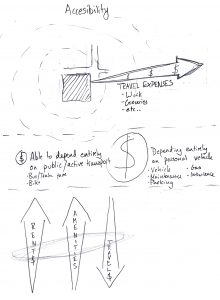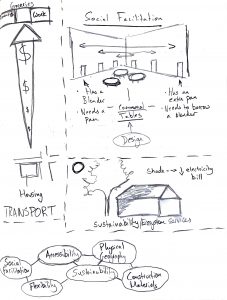

These sketches demonstrate the basic and uncontextualized economics that informed our initial idea of affordable housing. Surely, the more units on a site, the cheaper each unit? However, once contextualized in contemporary capitalist society, with land speculation, this is not necessarily the case. We maintained the simplified economic response for this initial assignment.

It is however true that social and ecosystem connection can mitigate costs.


Once ideas were developed individually; Vicky, Tarea, and I collectively brainstormed. We established a model to prioritize our ideas according to the personal finances of the affordable-housing resident. The most substantial expense was understood to be rent, which was prioritized above the rest. The second was found to be “accessibility” (meaning proximity and connectivity to amenities, goods, services, and transportation). Once again, these were not necessarily contextualized within the realm of designability, so priorities would change once design became a factor. This initial stage of prioritization was represented in the matrix below.
